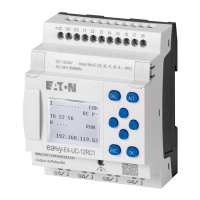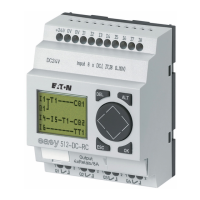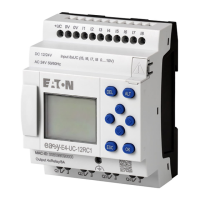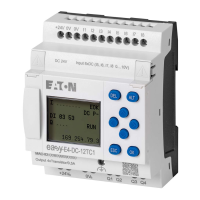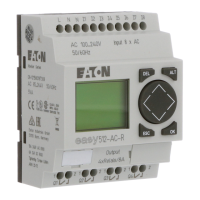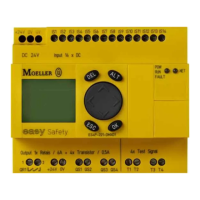10 Diagnostics possibilities
10.4 Transistor output
330 Control Relay easy800 11/11 MN04902001Z-EN www.eaton.com
10.4 Transistor output
To scan whether there is a short-circuit or an overload on an output of a
device with transistor outputs, use the internal inputs I15, I16, and use R15,
R16 if an expansion unit is connected.
• EASY82 .-D.-T..:
• I16: Group fault alarm for outputs Q1 - Q4.
• I15: Group fault alarm for outputs Q5 - Q8.
• EASY620-D.-TE (expansion unit):
• R16: Group fault alarm for outputs S1 - S4.
• R15: Group fault alarm for outputs S5 - S8.
• easy800-SWD
• I14: as group alarm out of function; permanently set to 1.
• I16: Group alarm for the outputs Q1/Q2
If both terminals are configured as inputs I3/I4, I16 is always 0.
The following examples show the use of the group fault alarm I16 for
checking the function of the transistor outputs Q1…Q4 on easy800 standard.
Example 1: Output with fault indication
Figure 218:Circuit diagram for fault output via I16
The above circuit diagram functions as follows:
If a transistor output indicates a fault, I16 sets marker M16. The N/C contact
of M16 switches off output Q1. M16 can be reset by switching the easy800
supply voltage off and on so that the N/C contact closes again.
State
Fault alarms I15 or I16, R15 or R16
No fault present 0 = switched off (N/O)
Fault present on at least one output 1 = switched on (N/O)
→
I15 and I16 can only be used on easy800 variants with transistor
outputs.
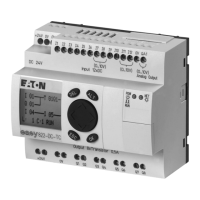
